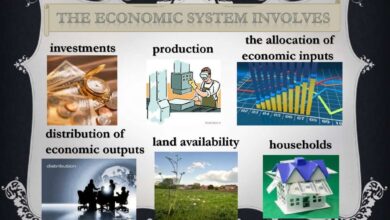Technological Changes are Closing the Gap between Developing and Developed Countries
TECHNOLOGICAL CHANGES

The world today is a much different place than it was even just a few years ago. Rapid technological innovations have helped to bridge the gap between developing and developed countries, making the world economy more accessible for all. In this blog post, we will explore how these technological advances are breaking barriers and helping to level the playing field in terms of economic success. From advances in communication technology to improved access to banking services, we will look at how technology is making a positive impact on the global economy.
Global Economy and the Impact of Technological Changes
In today’s interconnected world, the impact of technology on the global economy cannot be overstated. It has broken down barriers and created new opportunities for economic growth and development.
One of the most significant impacts of technology on the global economy is the ability to connect people and businesses from all corners of the world. Advances in communication technology, such as the internet and social media, have made it easier than ever before to reach a global audience. This has opened up new markets and expanded the reach of businesses, regardless of their location. It has also enabled small and medium-sized enterprises in developing countries to compete on a global scale, leveling the playing field and promoting economic equality.
Furthermore, technology has improved access to banking and financial services, particularly in developing countries. Mobile banking and digital payment systems have made it easier for people to save, invest, and access credit, which has contributed to financial inclusion and economic empowerment.
Technology has also transformed industries and disrupted traditional business models. The rise of e-commerce has revolutionized the retail sector, allowing businesses to reach customers anywhere in the world. Automation and artificial intelligence have streamlined processes and increased productivity, leading to economic growth and job creation.
However, it is important to acknowledge that technology has also created challenges and inequalities. The digital divide between developed and developing countries still persists, with limited internet access and technological infrastructure in many regions. Additionally, there are concerns about the impact of automation on employment, particularly in developing countries where the labor market is already vulnerable.

The Technological Changes between Developed and Developing Countries
As we delve deeper into the impact of technology on the global economy, it’s important to address the issue of the digital divide between developed and developing countries. While technology has undoubtedly brought about many positive changes, it has also highlighted and exacerbated existing inequalities.
The digital divide refers to the gap in access to technology and internet connectivity between different regions of the world. Developed countries often boast advanced infrastructure and high internet penetration rates, while many developing countries still struggle with limited access to technology and connectivity.
This divide has significant implications for economic growth and development. In the digital age, access to information and technology is crucial for businesses to compete on a global scale. Those with limited access are at a disadvantage, unable to tap into the opportunities offered by the digital economy.
Furthermore, the digital divide has widened the gap in educational opportunities. Online learning platforms and digital resources are transforming education, allowing students around the world to access high-quality educational content. However, without access to these resources, students in developing countries are at a disadvantage, hindering their ability to acquire the necessary skills for a technologically-driven economy.
Addressing the digital divide requires concerted efforts from governments, private organizations, and international institutions. Initiatives to improve infrastructure, expand connectivity, and promote digital literacy are vital steps towards bridging this divide. By ensuring equal access to technology and connectivity, we can create a more inclusive global economy, where opportunities are not limited by geographical boundaries.
The digital divide is a pressing issue that must be addressed if we are to harness the full potential of technology in driving economic growth and promoting equality. By closing this divide, we can create a more equitable and interconnected world, where everyone has the opportunity to thrive in the digital age.

Technological Changes Leveling the Playing Field in Global Economy
In today’s rapidly evolving world, technological innovations are playing a significant role in leveling the playing field in the global economy. These innovations have empowered individuals and businesses, regardless of their geographical location or economic background, to thrive and compete on a global scale.
One key technological innovation that is making a tremendous impact is the rise of cloud computing. Cloud computing has enabled businesses, especially those in developing countries, to access advanced computing resources and data storage capabilities that were previously out of reach due to high costs. This has allowed them to compete with larger, more established companies by harnessing the power of cutting-edge technology.
Another groundbreaking innovation is the development of mobile applications and digital platforms. These technologies have opened up new avenues for small businesses and entrepreneurs, providing them with the opportunity to reach a broader customer base and expand their market share. Mobile applications have made it easier for consumers to discover and purchase products and services from all over the world, without the constraints of physical boundaries.
Additionally, the advent of social media and digital marketing has leveled the playing field in terms of marketing and brand exposure. Previously, large corporations had a significant advantage due to their vast marketing budgets. However, with the rise of social media platforms like Facebook and Instagram, businesses of all sizes can now reach millions of potential customers through targeted advertising and engaging content.
Technological innovations have also enhanced collaboration and communication. With the availability of video conferencing tools and instant messaging platforms, businesses can easily connect and collaborate with partners, suppliers, and customers around the globe. This has not only improved productivity but has also opened up new business opportunities and partnerships, leveling the playing field for businesses of all sizes.

Global Economy and the Rise of Emerging Markets
In today’s rapidly changing global economy, emerging markets are playing a significant role in shaping the future of international trade and economic growth. As developing countries continue to adopt technological innovations, they are increasingly becoming major players on the global stage, challenging the dominance of traditional economic powerhouses.
The rise of emerging markets can be attributed, in large part, to advancements in technology. These countries have leveraged technology to improve their infrastructure, enhance their manufacturing capabilities, and promote entrepreneurship and innovation. Access to affordable mobile technology and the internet has opened up new avenues for business development, enabling emerging markets to reach a global customer base and compete with established players.
One of the key drivers of the rise of emerging markets is the growing middle class in these regions. As disposable incomes increase, consumers in emerging markets are demanding higher quality goods and services, creating new opportunities for businesses. With their large populations and growing consumer base, emerging markets are attracting investments and driving economic growth.
Additionally, emerging markets are increasingly investing in research and development, fostering a culture of innovation. Startups and entrepreneurial ventures are flourishing, with these countries becoming hubs for technological advancements and disruptive business models.
The rise of emerging markets presents both opportunities and challenges for the global economy. On one hand, it offers new markets and investment opportunities for businesses and investors. On the other hand, it increases competition and disrupts established industries.

The Transformation of Traditional Industries through Technological Changes
As technology continues to advance at a rapid pace, it is reshaping traditional industries in ways we could have never imagined. From manufacturing to healthcare, technology is transforming the way these industries operate, leading to increased efficiency, productivity, and innovation.
One area where technology has had a significant impact is in manufacturing. Traditional manufacturing processes often relied on manual labor, which could be time-consuming and prone to errors. However, with the advent of automation and robotics, manufacturing has become faster, more precise, and cost-effective. Robots can now perform repetitive tasks with greater accuracy and efficiency, allowing manufacturers to increase their production capabilities.
Similarly, the healthcare industry has been transformed by technology. The use of electronic health records and digital imaging has made patient information more accessible and streamlined. Doctors can now access a patient’s medical history, test results, and other crucial information at the touch of a button, improving diagnosis and treatment outcomes. Additionally, advancements in telemedicine have made it possible for patients to receive medical advice and consultations remotely, reducing the need for in-person visits.
Another industry that has been disrupted by technology is transportation. With the rise of ride-sharing platforms and autonomous vehicles, the way we travel is changing rapidly. Ride-sharing apps like Uber and Lyft have made it easier for individuals to get around without owning a car. Autonomous vehicles, on the other hand, have the potential to revolutionize the transportation industry by improving road safety, reducing congestion, and increasing energy efficiency.
The transformation of traditional industries through technology is not without its challenges. There are concerns about job displacement and the impact on workers in these industries. However, it is essential to recognize that technology also creates new job opportunities. For example, as automation takes over repetitive tasks, workers can be upskilled to take on more complex and higher-paying roles. Additionally, new industries and jobs are emerging as a result of technological advancements, such as data analytics and cybersecurity.

Job Creation and the Impact on Employment in Developing Countries
The impact of technology on employment in developing countries cannot be understated. While there are concerns about job displacement due to automation and advancements in artificial intelligence, there is also significant potential for job creation and economic growth.
Technology has the power to transform industries and create new opportunities for employment. As automation takes over repetitive and manual tasks, it frees up human resources to focus on more complex and value-added roles. This creates a demand for workers with the skills to manage and maintain the technology, as well as those with the ability to analyze and make decisions based on the data generated.
Additionally, the rise of technology has led to the emergence of entirely new industries and job sectors. Fields such as data analytics, cybersecurity, and digital marketing have seen significant growth and offer promising career prospects.
In developing countries, where job opportunities may be limited, technology can provide a lifeline. With access to the internet and digital platforms, individuals can tap into the gig economy and offer their skills and services on a global scale. This has the potential to uplift communities and provide income opportunities for those who may not have access to traditional employment.
However, it is essential to acknowledge that there are challenges to overcome. Developing countries must invest in education and training to ensure that their workforce is equipped with the skills necessary to thrive in a technologically driven economy. Additionally, governments and organizations must work together to address the digital divide and ensure that everyone has equal access to technology and connectivity.

Challenges and Opportunities in a Technological Changes Economy
In today’s rapidly evolving and technologically driven economy, there are both challenges and opportunities that we must navigate. One of the key challenges is ensuring that individuals and businesses have the necessary skills and knowledge to thrive in this digital age. As technology continues to advance, there is a growing demand for workers who are proficient in areas such as data analysis, artificial intelligence, and cybersecurity. This presents a significant opportunity for individuals to upskill and pursue careers in these emerging fields.
Another challenge is the ethical and social implications of technology. As automation and artificial intelligence become more prevalent, there is a concern about job displacement and the impact on the labor market. It is crucial for governments and organizations to address these concerns and develop policies and programs that support a smooth transition for workers.
Additionally, there is a need to ensure that technology is accessible to all, regardless of geographical location or economic background. The digital divide between developed and developing countries still persists, and efforts must be made to bridge this gap. This includes improving infrastructure, expanding connectivity, and promoting digital literacy.
Despite these challenges, there are numerous opportunities that a technologically driven economy presents. Technology has the potential to revolutionize industries, create new jobs, and drive economic growth. It allows for greater collaboration and innovation, enabling businesses to reach a global audience and expand their market share. Furthermore, technology has the power to improve efficiency, productivity, and sustainability in various sectors, leading to a more prosperous and sustainable future.
To fully leverage the opportunities presented by a technologically driven economy, it is crucial for governments, organizations, and individuals to embrace continuous learning and adaptability. By investing in education and training, fostering innovation, and promoting digital inclusion, we can create an economy that benefits everyone and ensures a brighter future for all.






2 Comments